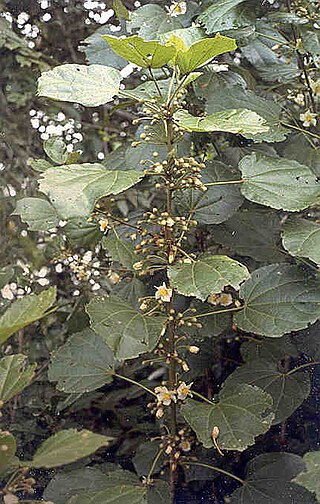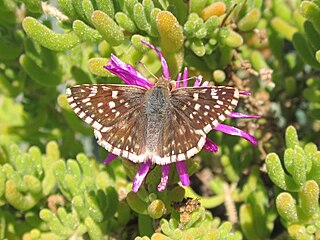
Skippers are a group of butterflies placed in the family Hesperiidae within the order Lepidoptera. They were previously placed in a separate superfamily, Hesperioidea; however, the most recent taxonomy places the family in the superfamily Papilionoidea, the butterflies. They are named for their quick, darting flight habits. Most have their antenna tips modified into narrow, hook-like projections. Moreover, skippers mostly have an absence of wing-coupling structure available in most moths. More than 3500 species of skippers are recognized, and they occur worldwide, but with the greatest diversity in the Neotropical regions of Central and South America.

Bibasis gomata, commonly known as the pale green awlet, is a butterfly belonging to the family Hesperiidae. It is found in Northeast India, the Western Ghats and parts of Southeast Asia. The butterfly was reassigned to genus Burara by Vane-Wright and de Jong (2003) and is considered by them to be Burara gomata.

Iambrix salsala, the chestnut bob, is a butterfly belonging to the family Hesperiidae, that is found in parts of South Asia and Southeast Asia.

Firetips or firetail skippers are skipper butterflies in the subfamily Pyrrhopyginae. The roughly 150 species are found only in the Neotropics, with the exception of one species which just reaches into the United States. Their common names refer to the red tuft at the end of the abdomen of many Pyrrhopyginae.

The Hesperiini or branded grass skippers are a tribe in the Hesperiinae subfamily of skipper butterflies. They are known as branded grass skippers because all the males in this tribe feature a black diagonal brand of scales on their forewings that exude pheromones to attract females.

Hampea is a genus of flowering plants in the family Malvaceae. They are trees native to Mexico, Central America, and Colombia. There are about 21 species.

Actinor is a Himalayan genus of butterflies in the family Hesperiidae. It is monotypic, being represented by the single species Actinor radians, the veined dart.

Choaspes plateni, commonly known as the branded awlking, is a species of butterfly belonging to the family Hesperiidae. It is found in Asia. Known food plants include Meliosma (Meliosmaceae) and Pometia (Sapindaceae)

Choaspes xanthopogon, the similar awlking, is a species of butterfly belonging to the family Hesperiidae.

Choaspes furcata, the hooked awlking, is a butterfly belonging to the family Hesperiidae.
Iliana is a genus of skippers in the family Hesperiidae. It was first described in 1937 by Ernest Layton Bell, with Iliana romulus as the type species. Species of the genus have a neotropical distribution.
Pamphilites is an extinct genus of skippers in the family Hesperiidae. It contains only one fossil species, Pamphilites abdita, recovered from the Tertiary of Aix-en-Provence, France.

Quasimellana is a genus of skippers in the family Hesperiidae with a distribution in South America and southern North America.

Wahydra is a genus of skippers in the family Hesperiidae. As of 2018 it consists of 15 species, including:

The Erionotini are a tribe of skipper butterflies in the subfamily Hesperiinae.

Moncina is a subtribe of butterflies in the skipper subfamily Hesperiinae.

Nicephellus is a monotypic genus of Neotropical butterflies in the family Hesperiidae, in which it is placed in tribe Phocidini.
Notamblyscirtes is a genus of grass skippers in the butterfly family Hesperiidae. There is one described species is Notamblyscirtes simius.

Burnsius is a genus of New World checkered-skippers in the butterfly family Hesperiidae. The genus was erected by Nick V. Grishin in 2019.

Chirgus is a genus of checkered-skippers, white-skippers, and allies in the butterfly family Hesperiidae, found in the New World. The genus was erected by Nick V. Grishin in 2019. There are about six described species in Chirgus.
















